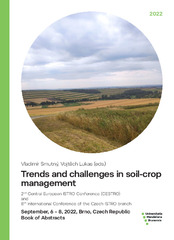Приказ основних података о документу
The Response of Soybean Yield to Different Cropping Pattern in a Long-term experiment on Chernozem
| dc.creator | Šeremešić, Srđan | |
| dc.creator | Rajković, Miloš | |
| dc.creator | Milić, Stanko | |
| dc.creator | Dolijanović, Željko | |
| dc.creator | Đalović, Ivica | |
| dc.creator | Vojnov, Bojan | |
| dc.date.accessioned | 2023-12-15T12:19:51Z | |
| dc.date.available | 2023-12-15T12:19:51Z | |
| dc.date.issued | 2022 | |
| dc.identifier.isbn | 978-80-7509-847-4 | |
| dc.identifier.uri | http://aspace.agrif.bg.ac.rs/handle/123456789/6600 | |
| dc.description.abstract | Considering the area and global production of the soybean, a relatively small number of papers address different aspects of its cultivation patterns and place in crop sequences. This leads to a lack of knowledge on the role and significance of soybean in different European cropping systems (CS). There is a consensus that soybean is favourable preceding crop and alongside soybean yield increases in crop rotations, however, the length and cropping patterns significantly affected the “rotation advantage” of soybean cropping systems. On the contrary, soybean monoculture has been widely used in practice despite potential adverse effects and higher risk of production. Therefore, the aim of this study was to assess yield differences of selected soybean cropping patterns in relation to the temperate climatic condition for 2008-2016 period. Analysed CS foreseen growing soybeans with maize (M), winter wheat (W) sugar beet (B) and soybean (S) as follows: (i) unfertilized 3-year rotation (MSW), (ii)3-year rotation (MSWf), (iii) 3-year rotation + cover crops (MSWccf), (iv) 4-year rotation (MSWBf), (v)monoculture SSSf and (vi) 3-year rotation with manure (MSWam). The trial was part of the long-term experiment“Plodoredi“ on the experimental station Rimski Šančevi of the Institute of Filed and Vegetable crops Novi Sadestablished on Haplic Chernozem. Regular tillage operations were used including mouldboard ploughing inautumn, compactor for levelling furrows in spring, multi-tiller for seedbed preparation and sowing in April. Inter-row cultivation and plant protection were done in May. Fertilization was not applied for soybean directly but forother crops in rotation with respect to soil chemical properties and anticipated yield. During 10 years period leadingsoybean varieties was grown with addition of biological fertilizer Nitragin. In average, a significantly higher yieldwas obtained at the 3-year fertilized rotation (3.25 t/ha) and the lowest at the monoculture (1.7 t/ha). Among theinvestigated years, a higher yield was obtained in 2013. and the lowest at 2017. A highly significant correlationwith soybean yield was found for rainfall (r=0.78** p<0.01) and a significant correlation for the temperature(r=0.74*, p<0.05) during the vegetation period (April-September). Climatic data evaluation reviled that asignificant effect on soybean yield for the temperature was found for August. For monthly sum rainfall, asignificant effect on yield was found for the June compared to other months. Our study demonstrates that soybeanin 3-year rotation benefited from crop sequence compared to monocropping. In addition, animal manure used formaize has not significantly affected soybean yield as well as growing soybean in a 4-year rotation. Maindisadvantages in monocropping are weed control and less efficient plant protection. Long-term unfertilizedsoybean demonstrated the adaptability of grown verities to low input systems and showed potential of sustainingyield in favourable years but the crop yield largely depends on the performance of winter wheat and maize. | sr |
| dc.language.iso | en | sr |
| dc.publisher | Mendel University in Brno, Zemědělská 1, 613 00 Brno, Czech Republic | sr |
| dc.relation | info:eu-repo/grantAgreement/MESTD/inst-2020/200117/RS// | sr |
| dc.rights | openAccess | sr |
| dc.rights.uri | https://creativecommons.org/licenses/by-nc-nd/4.0/ | |
| dc.source | 2nd Central European ISTRO Conference Brno, Czech Republic, 6 – 8 September 2022 | sr |
| dc.subject | crop rotation | sr |
| dc.subject | monoculture | sr |
| dc.subject | climate conditions | sr |
| dc.subject | yield | sr |
| dc.subject | chernozem | sr |
| dc.title | The Response of Soybean Yield to Different Cropping Pattern in a Long-term experiment on Chernozem | sr |
| dc.type | conferenceObject | sr |
| dc.rights.license | BY-NC-ND | sr |
| dc.citation.spage | 41 | |
| dc.identifier.fulltext | http://aspace.agrif.bg.ac.rs/bitstream/id/25158/Book_of_abstracts_CESTRO_2022_Brno.pdf | |
| dc.identifier.rcub | https://hdl.handle.net/21.15107/rcub_agrospace_6600 | |
| dc.type.version | publishedVersion | sr |


